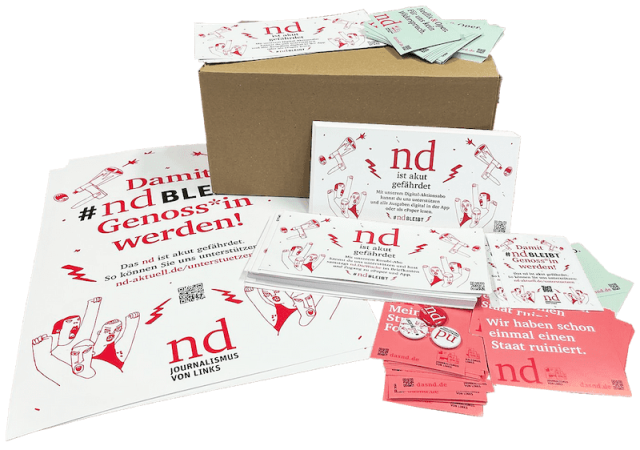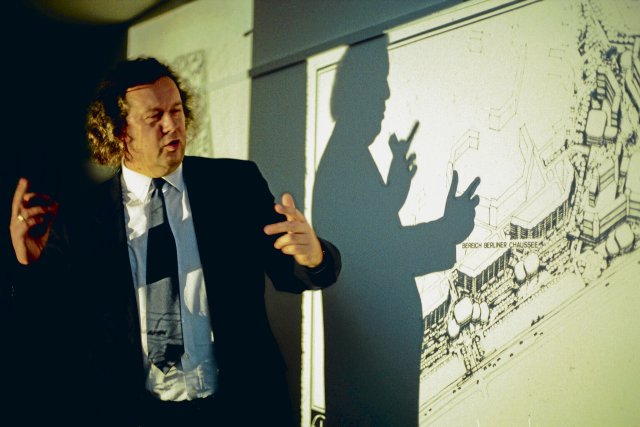Architecture professor Wolf R. Eisentraut in his Berlin office
Photo: picture-alliance/Berliner Zeitung/Wulf Olm
A few weeks before his 80th birthday, Wolf R. Eisentraut gave himself and us a book: “The joy of building was twofold.” One of the best-known contemporary architects offers insights into his varied work spanning over 50 years, almost exactly half in the GDR and half in unified Germany.
Eisentraut belongs to the generation of those who were born during the Second World War, seized their opportunity in the East German state and were able to prove it successfully, but after German unification had to reassert themselves under changed social conditions – and managed to do so. His father was already an architect in Plauen. The son who was born in Chemnitz on December 1, 1943 was not one of the “workers’ and farmers’ children” who explicitly received special support in the GDR, nor was he one of the Young Pioneers. Nevertheless, when his talent was recognized at high school, he was admitted to study architecture at the Technical University in Dresden due to his good Abitur.
Architect was also a sought-after career in the GDR, so there were many more applicants than places to study. Towards the end of the GDR, there were fewer than 1,000 students who were able to learn this profession. Eisentraut only became a member of the SED after his “ascension” had already taken place.
Eisentraut is still grateful to his teachers at school and college. The graduate was lucky enough to earn his first spurs in the newly established experimental workshop at the Institute for Urban Development at the Bauakademie in Berlin under the then “leading and best-known, albeit controversial, architect in the GDR,” Hermann Henselmann. He himself later took part in the development of the “WBS 70”, that is, the housing series made of prefabricated (board) building elements that helped to minimize housing shortages in many cities in the GDR. He was also jointly responsible for the design of the Palace of the Republic in Berlin, which was built between 1973 and 1976; he was just 29 years old at the time. He designed its central section with an entrance hall and also the novel and idiosyncratic theater in the palace, called Tip.
His buildings and urban planning designs shaped the large settlement in Berlin-Marzahn; In addition to the concept for the Marzahn promenade and individual buildings, he created the Marzahn town hall, which has been a listed building since 2008, and today’s leisure forum, but also the school for the physically disabled in Berlin-Lichtenberg and the “Galerie M”, which was unfortunately demolished in 2014.
Even after 1990, he was able to realize his designs in various cities – often in the “old” Federal Republic – including impressive examples of sensible, resource-saving dismantling and conversion of prefabricated buildings that were no longer needed. His entire work was characterized by the examination of the question of the role of architecture in society and its indispensable interaction with the economic and technical possibilities as well as the political and social framework conditions for building.
Eisentraut had to struggle with a number of difficulties and was not afraid to resolve conflicts. He knew how to overcome restrictive regulations and bureaucratic official reservations and achieve great things despite the GDR’s limited economic opportunities. It was not uncommon for his ideas to clash with those of those responsible for the state as clients. He self-confidently and persistently promoted his ideas, practical and aesthetic solutions that were compatible with the plan specifications. He also found supporters willing to make decisions, for example among company directors.
The Marzahn leisure forum is one such example. Contrary to the usual approach, the architect combined the individual projects that had been pre-planned for the complex housing construction, such as a sports hall, swimming pool, youth club, library, hall with stage and more, into a new whole. This not only included an elegant foyer and staircase, but also one of the ceiling paintings that were rarely found in new buildings then and now, there by Peter Hoppe “The Morning – The Day – The Evening – The Dream”. Art in architecture in the best sense. After unification, the district was faced with the task of keeping alive this complex of public services and culture, for which the public administration was no longer actually responsible. A challenge still today.
The Marzahner Promenade and the Marzahner Tor in particular illustrate the fundamental architectural and urban planning differences between the Federal Republic and the GDR, which were and are system-related. Demolition decisions that supposedly have no alternative are due to the selfish interest of powerful private investors. Eisentraut comments: “Using the example of the Marzahn center, one can at least identify some characteristics of architecture under socialism or architecture under capitalism.”
When the then Berlin city planning director said at a public event in 1990 that the architectural profession did not even exist in the GDR, Eisentraut contradicted himself and introduced himself and some of his colleagues with their works. His question as to which buildings the highest building official in Berlin could prove was later quoted as an anecdote in the guild for a long time.
This episode was indicative of the disparaging assessment of achievements in general in the GDR as well as specifically in the architectural field that was widespread at that time – up to and including the disregard and negation of copyrights as well as building or planning regulations from the GDR. Eisentraut is one of the few architects who fought successfully for the recognition of their copyrights. Copyright law also existed in the GDR; it was by no means invalidated by the so-called collective system in the companies.
Eisentraut is still involved today – now accepted and respected – in an advisory capacity in the further structural design of the leisure forum and the town hall in Marzahn. According to the contemporary witness, the architecture of the GDR “will go down as a special feature in German architectural history.”
“The joy of building was twofold,” an exhibition in honor of the architect Wolf R. Eisentraut, opening on December 3rd (4 p.m.) in the Marzahn-Hellersdorf District Museum, House 1, Alt-Marzahn 51, Berlin. the book of the same name was recently published by Lukas-Verlag (€40); Reading on December 17th in the Peter Weiss Library in Hellersdorf (10:30 a.m.) in Berlin, Hellersdorfer Promenade 14.
Our author Dr. Heinrich Niemann was district councilor for urban development in Marzahn-Hellersdorf from 1995 to 2006.
#ndstays – Get active and order a promotional package

Regardless of whether it is pubs, cafés, festivals or other meeting places – we want to become more visible and reach everyone who values independent journalism with an attitude. We have put together a campaign package with stickers, flyers, posters and buttons that you can use to get active and support your newspaper.
To the promotional package
link sbobet judi bola online slot demo sbobet88
